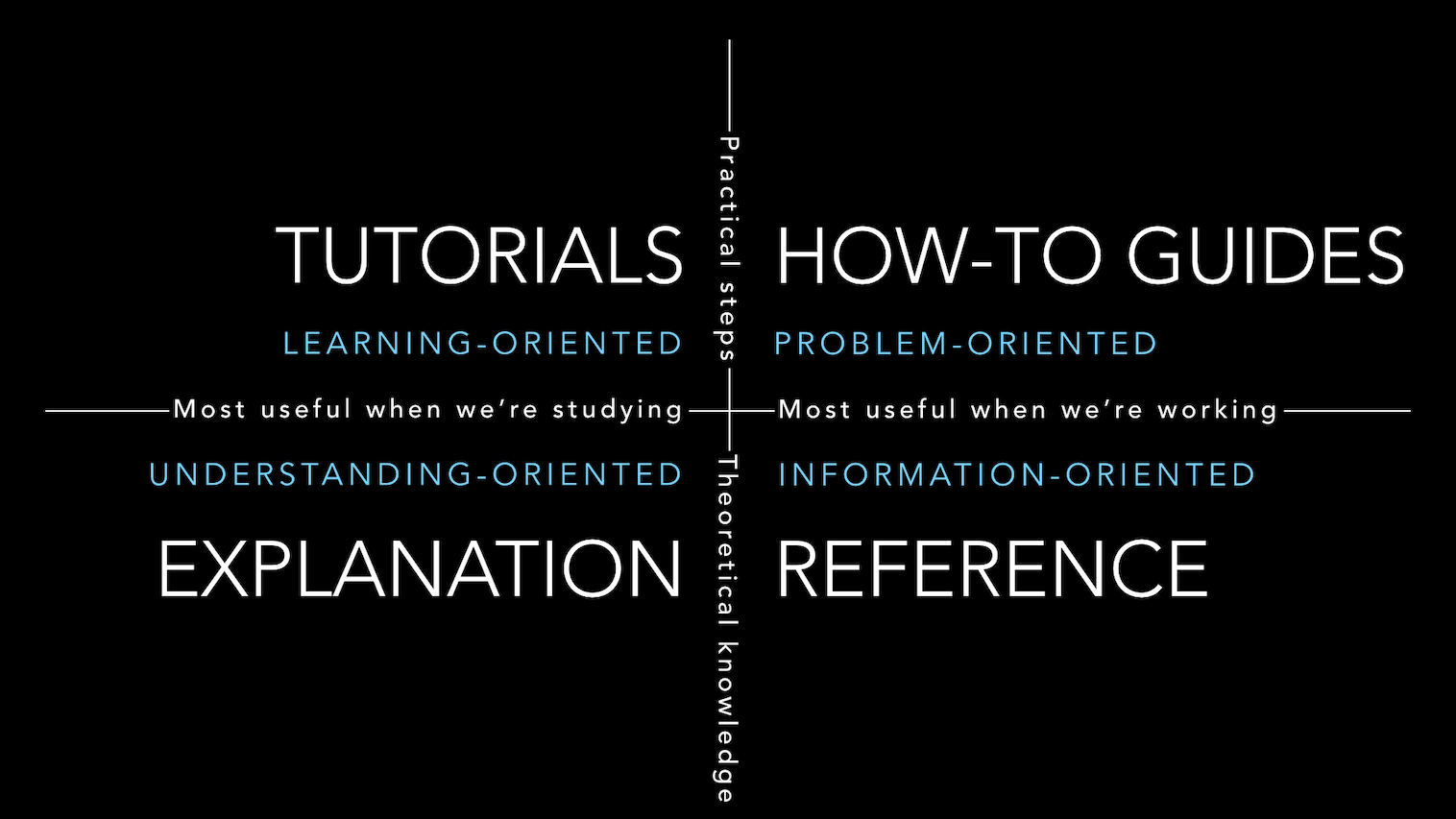The mistake most devs make when trying to document their project is that they only make one (maybe two) types of documentation based on a readme template and/or what their mental model of a newcomer needs.
Devs need to be actively taught that:
- Good documentation isn’t one thing, it’s four. To have good documentation, you need all four distinct types of documentation.
- What the four types of documentation are (this is discussed in the link)
If you don’t have all four types of documentation, you have bad documentation.
Tutorials
Tutorials are lessons that take the reader by the hand through a series of steps to complete a project of some kind. They are what your project needs in order to show a beginner that they can achieve something with it.
They are wholly learning-oriented, and specifically, they are oriented towards learning how rather than learning that.
How-to guides
How-to guides take the reader through the steps required to solve a real-world problem.
They are recipes, directions to achieve a specific end - for example: how to create a web form; how to plot a three-dimensional data-set; how to enable LDAP authentication.
They are wholly goal-oriented.
Reference guides
Reference guides are technical descriptions of the machinery and how to operate it.
Reference guides have one job only: to describe. They are code-determined, because ultimately that’s what they describe: key classes, functions, APIs, and so they should list things like functions, fields, attributes and methods, and set out how to use them.
Reference material is information-oriented.
Explanation
Explanation, or discussions, clarify and illuminate a particular topic. They broaden the documentation’s coverage of a topic.
They are understanding-oriented.

-
tutorials and how-to guides are both concerned with describing practical steps
-
how-to guides and technical reference are both what we need when we are at work, coding
-
reference guides and explanation are both concerned with theoretical knowledge
-
tutorials and explanation are both most useful when we are studying, rather than actually working
I’ve had that article saved for years, it’s still the best way to break down documentation imo.
Another key point for code documentation is that the closer it is to the code it’s describing, the more likely it is to be read and maintained. The book “A philosophy of software design” has a section on it.
Another key point for code documentation is that the closer it is to the code it’s describing, the more likely it is to be read and maintained.
What does this mean?

-
How much time do they think we have?
Dear ChatGPT, please scan my code and generate documentation for the same junk in 4 different styles.
I am glad that this issue is being addressed. I think it is also worth mentioning, that it is more worth the time to document your code now, than it is to waste time later, trying to figure out what the code does. Many project leads are unwise when it comes to this, and therefore fail to allocate the proper time. This will inevitably lead to unmaintained/unreadable code later down the road. This is bad for many reasons: You cannot reuse the code, you cannot maintain old code, programmers will become angry, ETC…
Don’t like leaving anything to the imagination, right?
I feel like the original source for this is diataxis.fr.
Yeah it looks like it, I wonder if the authors there had some sort of professional relationship with my link’s host
Hey, I just found that it is common to think that divio plagiarized from diataxis. It is not. A person at divio came up with this and asked permission to spin it off into its own website.
I just learned this from footnote at this article: https://www.hillelwayne.com/post/problems-with-the-4doc-model/#fn:diataxis





